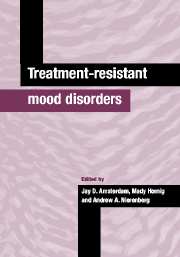Book contents
- Frontmatter
- Contents
- List of contributors
- Preface
- Part I The clinical problem
- 1 The characterization and definition of treatment-resistant mood disorders
- 2 Overview of treatment-resistant depression and its management
- Part II Biological basis
- Part III Treatment approaches
- Part IV Special patient populations
- Part V Economic and ethical issues
- Index
- Plate Section
2 - Overview of treatment-resistant depression and its management
from Part I - The clinical problem
Published online by Cambridge University Press: 25 March 2010
- Frontmatter
- Contents
- List of contributors
- Preface
- Part I The clinical problem
- 1 The characterization and definition of treatment-resistant mood disorders
- 2 Overview of treatment-resistant depression and its management
- Part II Biological basis
- Part III Treatment approaches
- Part IV Special patient populations
- Part V Economic and ethical issues
- Index
- Plate Section
Summary
Introduction
Although the therapeutic armamentarium available for the clinician treating major depression has expanded substantially over the last decade, the percentage of patients with treatment-resistant depression (TRD) remains unchanged and continues to be an important clinical problem. In spite of aggressive pharmacological and psychotherapy approaches, 10–15% of patients will remain chronically depressed with a significant psychosocial morbidity and a mortality rate by suicide (Keller et al., 1992). Although this percentage represents the minority of patients who have minimal or no response to at least one adequate therapeutic trial of an antidepressant, this figure obscures the more general problem of partial response or ‘relative’ TRD in 50–70% of patients undergoing antidepressant treatment (Fawcett, 1994).
In this chapter, the concept of TRD will be defined and distinguished from ‘pseudo-TRD’ resulting from either misdiagnosis, unrecognized concurrent medical and psychiatric illnesses, inadequate antidepressant treatment or unrecognized pharmacokinetic factors interfering with adequate treatment. Thus in ‘pseudo- TRD’ the treatment is judged to be inadequate for specific reasons and could not have reasonably been expected to be successful. In this regard, the criteria for what constitutes ‘adequacy’ of treatment will be examined more closely. Finally, several approaches for optimizing treatment and minimizing resistance in depressed patients will be reviewed, as well as some suggested approaches for directly treating TRD.
Keywords
- Type
- Chapter
- Information
- Treatment-Resistant Mood Disorders , pp. 30 - 46Publisher: Cambridge University PressPrint publication year: 2001
- 6
- Cited by



